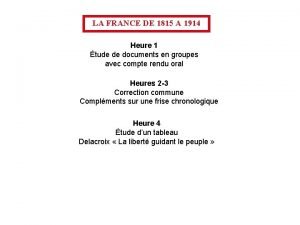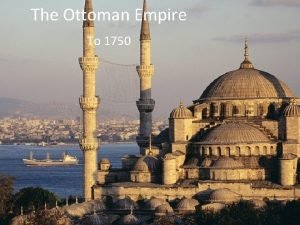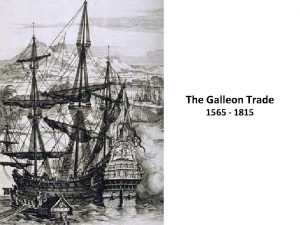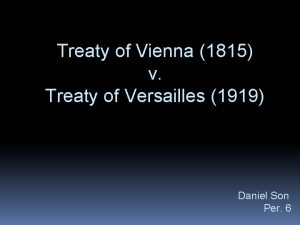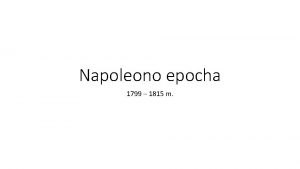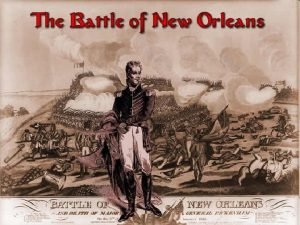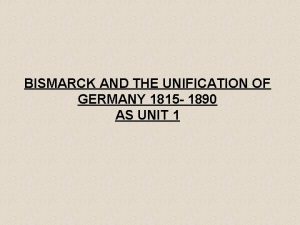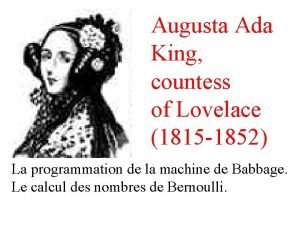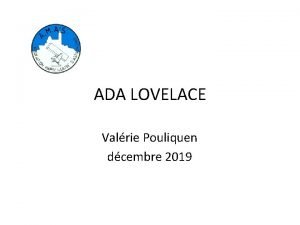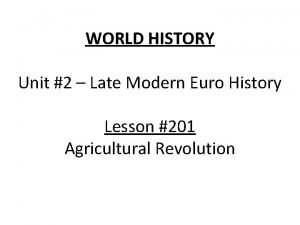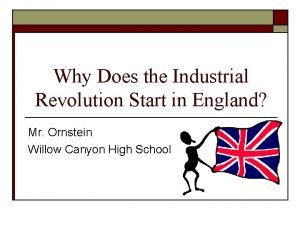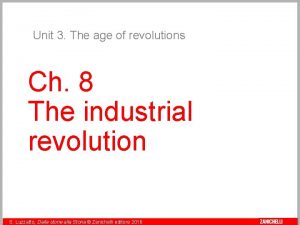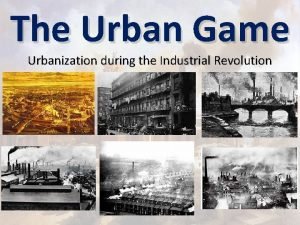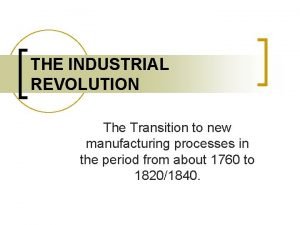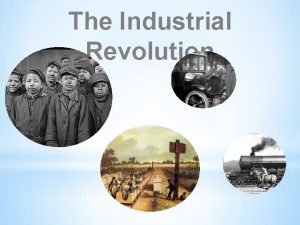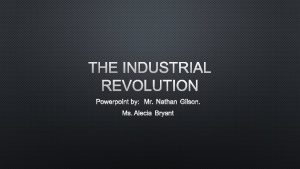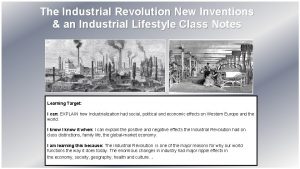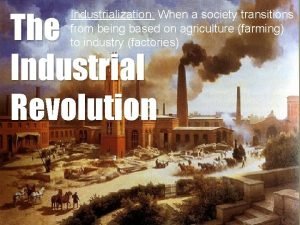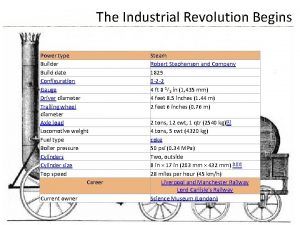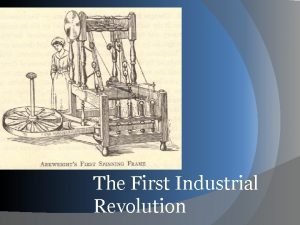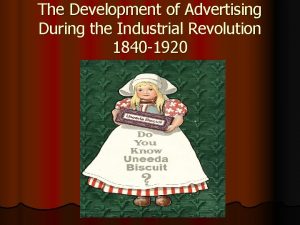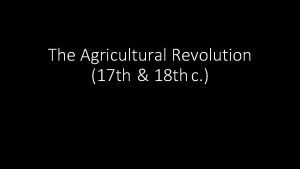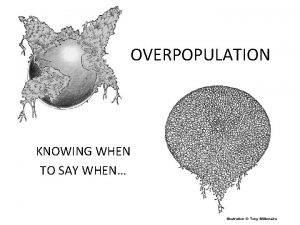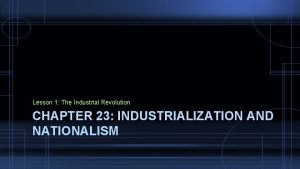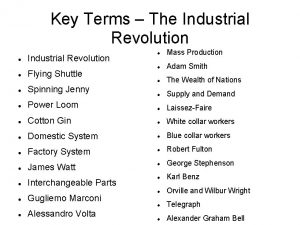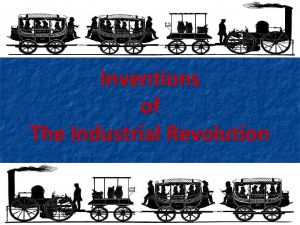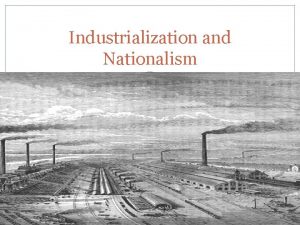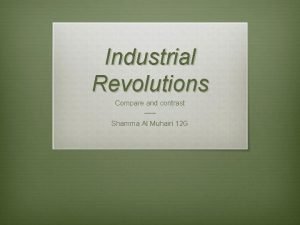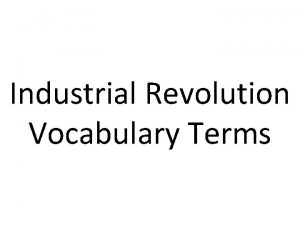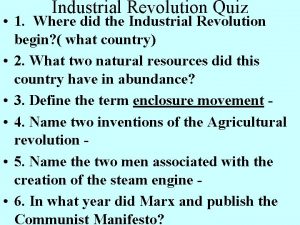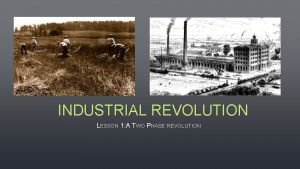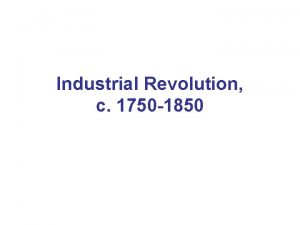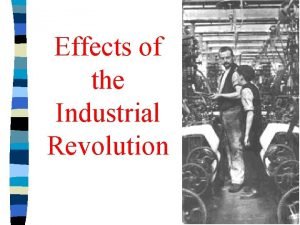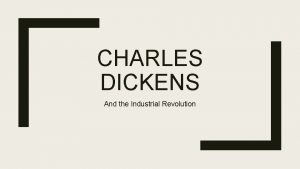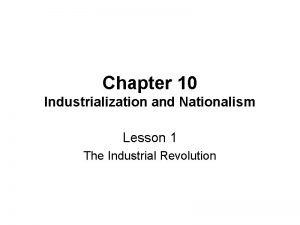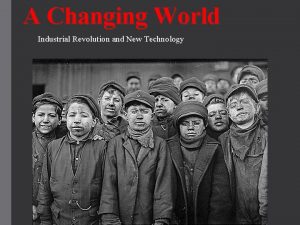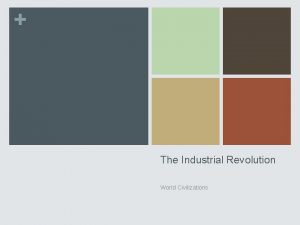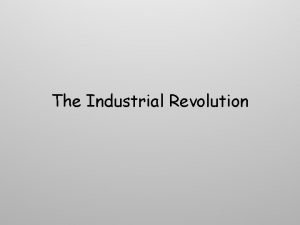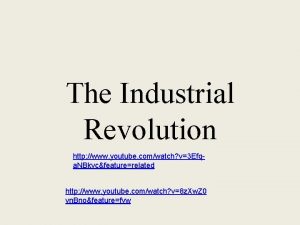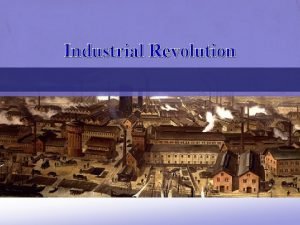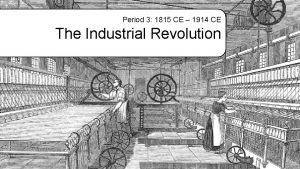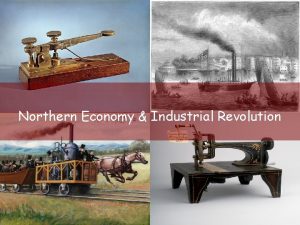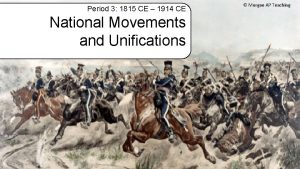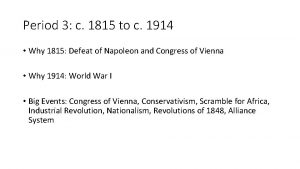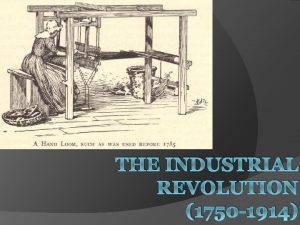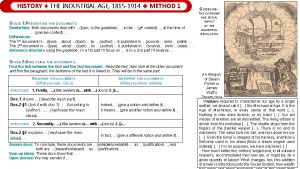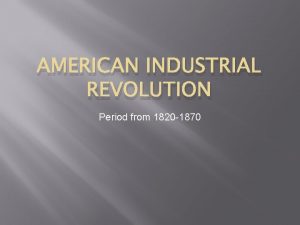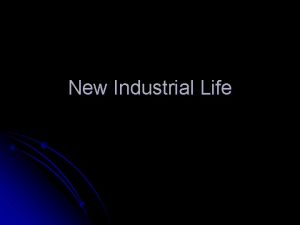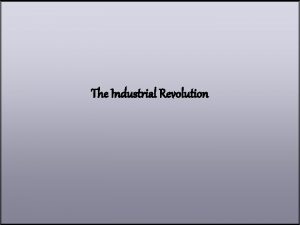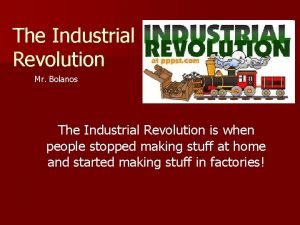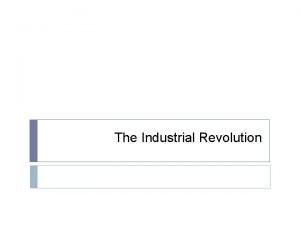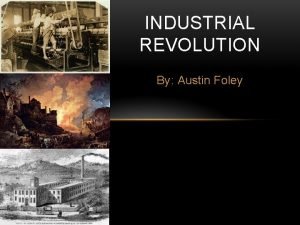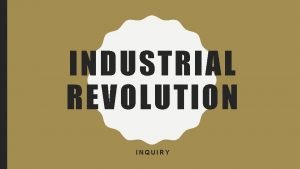Period 3 Review 1815 1914 THE INDUSTRIAL REVOLUTION






















































- Slides: 54

Period 3 Review 1815 -1914

THE INDUSTRIAL REVOLUTION AGE OF ISMS REALISM ROMANTICISM REVOLUTIONS OF 1820 S-1830 S

Events leading up to IR n Commercial Revolution (1500 -1800) – Age of Exploration – Price Revolution – Capitalism – Scientific revolution – Population growth n Proto-Industrialization – Putting out system – Cottage industry – technology

Why did Industrialization begin in England? Contributing Factors: 1. 2. 3. 4. 5. 6. Agricultural revolution: Population growth (labor supply) Supply of capital to invest & entrepreneurs seeking profits; highly developed banking system Rich in natural resources, Government’s “laissez-faire” attitude towards econ. and social regulation; politically stable Large Empire provided a market for goods & a source of raw materials

Agricultural Revolution Year Sheep (lbs) Cattle (lbs) 1710 28 370 1795 80 800 1. Enclosure movement: 2. Methods such as crop rotation and selective breeding were employed by the scientific farmers. Y 2 Y 4 Jethro Tull was one of the first scientific farmers.

Proto-Industrial Changes in Cotton Production: the Textile Industry From Cottage Industries Machine Work Hargreaves’ Spinning Jenny 1764: Arkwright invented the Waterframe in 1769. 1. Industrialization began in textile industry; specifically the demand for cotton 2. One invention led to another as spinners and weavers tried to keep up with demand for cotton cloth: – – Flying shuttle (1733) Spinning Jenny (1764) Water frame (1769) Spinning mule (1779)

The steam engine & coal n Thomas Savory and Thomas Newcomen developed steam pump to remove water from mines n JAMES WATT’S (1769) steam engine n Development of heavy industry n Henry Cort: 1780 s – “puddling” refined iron for building and industrial grade wrought iron and steel The Cotton Gin: Eli Whitney 1793

The Transportation Revolution Effects of the RR 1. Spurred industrial growth by giving manufacturers a cheap way to transport goods & raw materials 2. Created new jobs for RR workers, construction, and miners 3. Boosted agricultural and fishing industries 4. Increased travel both for pleasure and allowed people to take distant jobs Robert Fulton’s Steamboat (1807) provided fast, easy transportation of both raw materials and finished goods. In 1804, the 1 st steam-powered locomotive ran on an industrial rail line. “The Iron Horse” or “The Rocket”

By 1850, Britain leads industrial growth 2/3 world’s coal ؽ worlds iron Ø> ½ world’s cotton cloth Ø 1801 -1850: ØGNP rose 350% ØPer capita income rose 100% ØInternational exhibit to showcase Britain’s industrial, economic, and military superiority n Crystal Palace, 1851

Industrialization Spreads after 1815: Continental Europe & US

British Monopoly on Industrialization n Up until 1825 it was illegal for engineers, mechanics, and toolmakers to leave England n Until 1843, export of textile machines and equipment illegal n Many emigrated illegally n Tariffs: used to protect domestic industry – France imposed tariffs on British goods – 1834: Zollverein – German tariff policy established free trade zone among member states and a uniform tariff on foreign goods German Zollverein, 1834– 1919 Blue: Prussia in 1834 Grey: Areas included until 1866 Yellow: Austrian possessions outside the Zollverein Red: Borders of the 1828 German Confederation (wikipedia)

Rise of Global Inequality A. First nations to industrialize (Western Europe, the United States, Japan) became wealthy, powerful nations B. Industrialization leads to Imperialism: – – – Widened gap b/w industrialized and non-industrialized countries Required steady supply of raw materials Exploitation of overseas colonies for Markets and Materials

III. Social Impact of Industrialization: New Social Order Rise of the Middle Class “bourgeoisie” 1. 2. 3. 4. Ind. Rev. created wealth for factory owners, shippers, merchants, bankers changing the social structure Upper middle class did not become social equals of aristocrats until late 19 th C. (gov. workers, doctors, lawyers, managers, entrepreneurs) Lower middle class “petite bourgeoisie” had comfortable standard of living (factory overseers, skilled workers, drafters, printers) Working poor “proletariat”: low standard of living n n n As machines replaced workers, created anger Luddites: smashed machines, attacked factories, riots Union Movement & government response

1. After 1800, change from rural to urban as people moved from country to find work in the cities in factories & mines 2. Most city pop. doubled, or even tripled Rapid, unplanned pop. growth leads to social problems: 1. No planning for housing, sanitation, ed. , police protection, building codes 2. Lack of sanitation & overcrowding led to disease: n Cholera epidemics n Shorter life spans 3. Poor lived in filthy, one-room homes while upper middle class lived in suburban areas 4. Growing gap b/w rich and poor 5. Poorhouses (Poor Laws) 6. Irish Potato Famine (1845 -46, 1848 -51) Urbanization

Government Intervention & Regulation 1. 2. 1819: 1 st Factory Act passed by British gov. to restrict working age & hours 1833: 2 nd Factory Act passed by Parliament to further regulate child labor: – 3. Illegal to hire under 9; 9 -12: 8 hrs. , 13 -17: 12 hrs. , by 1847: 10 hrs. Act 1842: Mines Act – – Regulate child labor in coal mines Prevented women & children from working underground 4. 1847: Ten Hours Act

Realism, mid-19 th Century 1. Industrialization and urbanization spread from England to the U. S. and the Continent of Europe in the 19 th Century. 2. Western cities grew dramatically due to migration from rural areas due to new job opportunities, as well as improving health and living conditions. 3. Scientific advances led to industrial growth. 4. Charles Darwin’s theory of natural selection promoted an interest in science and challenged traditional Christian beliefs, which led to the rise of secularism. • Darwin’s theory was applied to Edouard Manet, Olympia, 1863, Musee d’Orsay, Paris. socioeconomics in that those that industrialized became the most economically “fit” companies and countries. This was used to justify Western racism, imperialism, nationalism, and militarism going into the early 20 th Century. • Industrialization & Social Darwinism were the justification for the colonization by Western nations of peoples they believed were inferior to them on a social and national hierarchy. Gustave Courbet, The Stone Breakers, 1849, Dresden.

Karl Marx & Class Struggle 1. Marx believed those that controlled the means of production did so at the expense of the exploitation of the laborer. (Haves vs. Have-nots) 2. He hoped to create a socialist state in which the workers would seize power and destroy capitalism. Jean-Francois Millet, The Gleaners, 1857, Louvre, Paris. 3. His theory of class struggle appealed to the oppressed and led to the rise of trade unions and socialist groups. Honore Daumier, Rue Transnonain, 1834, lithograph, Philadelphia.

Paintings of Modern Life • Realism is considered the first modernist movement. • Artists and writers of the realist movement were reevaluating “reality” and focused on only what they could see and experience on a daily basis. • They did not paint fictional subjects because they were not real nor visible in the present world. • Realists portrayed scenes that were not considered worthy prior to this period. Scenes of laborers, peasants, and daily life. Gustave Courbet, Burial at Ornans, 1849, Louvre, Paris. Honore Daumier, The Third Class Carriage, 1862, The Met, NY.

• • • Romanticism, 18 th-19 th Centuries: “Trust your heart Reaction against neoclassicism’s rather than your head. ” emphasis on reason and order; inspired by Rousseau’s Social Contract: “Man is born free, yet everywhere he is in chains!” Emphasis on emotion in art, individual liberty, ending social injustices, and achieving democracy; the path to freedom was through imagination and feeling (rather than reason and thinking) Romantic artists to know: Delacroix, Goya, Gericault, Turner Goya, Saturn Devouring One of His Children, 1819 -1823, Prado, Madrid, Spain. “I am like no one in the whole world. I may be no better, at least I am different. ” Rousseu Franciso de Goya, The Family of Charles IV, 1800, Prado, Madrid, Spain.

Delacroix, Liberty Leading the People, 1830, Louvre, Paris. Turner, The Slave Ship, 1840, Boston, MA. Gericault, Raft of the Medusa, 1818 -1819, Louvre, Paris. Delacroix, Death of Sardanapalus, 1826, Louvre, Paris.

Liberalism in the 19 th Century 19 th C. Conservatism Classical Liberalism: “that government is best which governs least” • Government that protects liberty of the people from others and itself – Thomas Paine, Common Sense • Natural rights • Social Contract Theory – Rousseau’s “general will” – Locke • Protection of property rights • Anticlerical, anti-aristocratic • Coupled with economic theory: free market capitalism (Adam Smith) – Free trade: John Stuart Mill, David Ricardo • Utilitarianism: Jeremy Bentham, Mill • • • Reaction to liberalism and excesses of the French Revolution – Edmund Burke – Joseph de Maistre – Metternich: failure to suppress liberalism and nationalism longterm (Revolutions of 1848) Supported by Church, Royalists, peasants Continuity and stability of institutions that have evolved gradually over time

• • Liberalism: Left Wing Reform/Change society acc. to ideals of Enlightenment and French Rev. Middle class Similari Emphasis on individual ties freedom Individual growth Separation of state and church Limited monarchy • • Conservatism: Right Wing Strengthen traditional society Upper class Emphasis on community Preserve Social hierarchy Established church Supported status quo Legitimate institutions Rejection of radicalism and violence, recognized need for limits on the powers of government, advocacy of balance in society regarding individual rights and societal powers –not so similar if analyzed further

Revolutions 1820 -1831 • Greek Revolt (1821): independent 1830 • Decembrist Revolt (1825) • Paris, 1830: 3 Glorious Days – Charles X abdicates in favor of Louis-Philippe “July Monarchy” and House of Orleans (overthrown in 1848) • Belgium, 1830 – Independence from Dutch • Poland, 1830

REVOLUTIONS OF 1848 “THE SPRINGTIME OF PEOPLES” UNIFICATION OF ITALY AND GERMANY

• Causes of the Revolutions of The Hungry 40 s 1848 – Crop failure – High prices – Unemployment – Potato blight – Increase in crime – Radicalization of politics • Abdication of Louis-Philippe, 1848 and the rise of the 2 nd Republic under Louis Napoleon • Revolts across Europe calling for constitutionalism, liberalism, rights – free expression, including press – Britain and Russia exceptions

Revolutions of 1848

“When France sneezes, Europe catches cold” –Metternich Italy • • • Austria Giuseppe Mazzini (nationalist Giuseppe • Garibaldi • Italian states desire freedom from foreign rule Put down by Catholic alliance of France • and Austria • • • Multi-ethnic, susceptible to revolt Forced Metternich out, new Emperor, Franz Joseph I grants a new constitution Gain peasant support by abolishing feudalism Hungarian Magyars demand autonomy Revolution suppressed not due to strength of Hapsburgs, but division of revolutionaries Hapsburgs agreed to Ausgleich – nearly co-equal status to King of Hungary

Germany • Pan-Germanism: unify German speaking countries of Europe • Prussian King Frederick William IV convenes Frankfurt Parliament • “To My People and to the German Nation” – Constitutional monarchy – Rejected constitution and without Prussia, constituent assembly dissolved

The Crimean War, 1853 -1856 • • • Ottoman (the “sick man of Europe”) allied with France, Britain, and Sardinia to defeat Russian expansionism Battle of Balaklava, Charge of the Light Brigade, 1854 – Alfred Lord Tennyson – Florence Nightingale Peace of Paris, 1856 – Russia out of the Black Sea • Determined to restructure militarily and industrially • Expands east – Laid foundation for Italian and German unification


Unification of Italy and Germany, 1871 Italy, 1870 • • Risorgimento Prime Minister Camillo di Cavour, Kingdom of Piedmont-Sardinia – Defeated Austria with French help in Franco-Austrian War 1859 – Garibaldi brought the southern part of the peninsula – Unified most of Italy by 1861 – Venice, 1866 (Austro-Prussian War) – Rome, 1870 (Franco-Prussian War) • • • Bismarck’s real-politik Zollverein Kleindeutschland vs. Grossdeutschland 1862 Danish War 1866 Austro-Prussian War – North German Confederation 1870 Franco-Prussian War

THE AGE OF MASS POLITICS (18711914) IMPRESSIONISM/POSTIMPRESSIONISM THE SECOND INDUSTRIAL REVOLUTION

The Age of Mass Politics: The 3 rd French Republic, 18701940 Politically unstable monarchists vs republicans Adolphe Thiers, 1 st president, moderate republican Constitution 1875, little power to the president Stained by scandal: Panama Canal Scandal, 1888 Dreyfus Affair, 1894 Victorian England (1837 -1901) • Largest, most prosperous empire in the world • Naval supremacy • Industrial Revolution • Politics: – Tories (Conservatives) under Disraeli vs. Whigs (Liberals) under Gladstone – Reform Act of 1867 – Irish question – Suffragette movement

Impressionism, 19 th Century • Edouard Manet, Le Dejeuner sur l’herbe, 1863 at Salon des Refuses • Claude Monet, Impression – Sunrise, 1872

A Bar at the Folies-Bergere, 1882

Auguste Renoir, Dance at the Moulin de la Galette, 1876

Berthe Morisot, Villa at the Seaside, 1874

Gustave Caillebotte, Paris: A Rainy Day, 1877

Edgar Degas, Musicians in the Orchestra, 1872

Post-Impressionism: Georges Seurat, La Grande Jatte, 1884 -86

Paul Cezanne, Basket of Apples, 1890 -94

Paul Gaugin, Sacred Spring, Sweet Dreams, 1894

Vincent van Gogh, The Night Café, 1888

1 st Ind. Rev. 2 nd Ind. Rev. Time Frame c. 1760 -1830 c. 1850 -1914 Methods Hand Machine Increased Automation Textiles Steel (Bessemer Process) Power Sources Water, Coal, & Steam* Petroleum & Electricity New Engines Steam Engine* Internal Combustion Inventions Spinning Jenny Water Frame Spinning Mule Cotton Gin Automobiles Chemicals Railroads (Prevalent) AWFUL Still Bad, but improving of Production Mass Production Standard of Living for working class Think Tocqueville in Manchester * Telegraph, Telephone, Radio (Sewers, Sanitation, etc. ) Expansion of Middle Class Note that these technologies continued to be used during the 2 nd IR but new sources of power were introduced, in addition.

The Second Industrial Revolution – Technology Timeline Lightbulb is developed. 1870 s Telephone is invented (1876). Public lighting is available. For the public. 1880 s 1890 s Automobile is developed. Radio developed (1910 s). 1900 s. . . Flyin’ machines invented. back to selection

What sparked the Second Industrial Revolution? STEEL ELECTRICITY Production led to: Usage led to: ▪ Improved transportation: production of automobiles and subways. ▪ Development of Thomas Edison’s incandescent light bulb in the 1870’s. ▪ Lighter and more durable building material for new constructs. ▪ Public lighting in major cities. ▪ Displacement of iron in production of machines and firearms. ▪ New form of power and energy for industries, factories, generators, turbines, and motors.

Comparison of Leading Industrial Nations France increased industrial production that equaled that of Great Britain’s a generation earlier by the beginning of the 20 th century. Germany economy boomed and production rates skyrocketed for several industries in which Germany became the leader due to the institutions of machines and factories as well as abundant resources within the country itself*. The industrial production of the United States, just as that of Germany had, rapidly grew, as immigrants traveled in, new factories that were updated and more efficient were instituted, and the territory expanded to find its own abundance of natural resources used in industrial production. The industry of Great Britain continued to gradually increase, but the relative lack of newer technologies and efficient machines, as well as the country’s ignoring of steel production led to a slower industrial growth compared to that of Germany and the United States. *See charts on p. 741 of The Western Experience (Chambers) for visual comparison of industrial production.

Age of Empire: Motives (the Why? ) • • Gold Glory God Social Darwinism

How? A. European Advantages: 1. Maxim gun (1889) 2. Steam engine 3. The cure for malaria B. African Disadvantages: 1. Diversity of population 2. Low level of technology

IV. Berlin West Africa Conference 1884 -5 Divides Africa 1. Convened by Germany’s Bismarck to set rules for annexing African territory Purpose: to prevent war amongst Europeans 14 Eur. nations attended; no African rulers present Outcome: annexation of African terr. only recognized when “effective occupation” demonstrated By 1914 only Liberia & Ethiopia remained independent 2. 3. 4. 5. – 6. Battle of Adwa, 1896 Conference successful in avoiding Eur. War with 1 major exception: South Africa


European Clashes Fashoda Incident, 1898 Boer War, 1899 -1902

British Empire French Empire

Belgium: King Leopold I
 Frise chronologique 1815 à 1914
Frise chronologique 1815 à 1914 Ottoman empire 1750-1900
Ottoman empire 1750-1900 What is the route of the galleon trade from 1565 to 1815?
What is the route of the galleon trade from 1565 to 1815? Congresul de la viena ppt
Congresul de la viena ppt Treaty of vienna 1815
Treaty of vienna 1815 Reino sąjungos įkūrimas
Reino sąjungos įkūrimas Frise chronologique 1815 à 1870
Frise chronologique 1815 à 1870 We fired our guns and the british kept a comin
We fired our guns and the british kept a comin 1815
1815 Liberalism and nationalism in germany 1815-71
Liberalism and nationalism in germany 1815-71 Lovelace 1815
Lovelace 1815 Ada lovelace family background
Ada lovelace family background Sdružení pro vydávání a šíření českých knih
Sdružení pro vydávání a šíření českých knih Russian revolution vs french revolution
Russian revolution vs french revolution How could the french revolution been avoided
How could the french revolution been avoided Definition of third agricultural revolution
Definition of third agricultural revolution Enclosure movement
Enclosure movement Why did the industrial revolution start in britain
Why did the industrial revolution start in britain The industrial revolution zanichelli
The industrial revolution zanichelli The urban game industrial revolution
The urban game industrial revolution Enclosure movement industrial revolution
Enclosure movement industrial revolution Putting-out system
Putting-out system Industrial revolution transition
Industrial revolution transition Industrial revolution quiz
Industrial revolution quiz Industrial revolution powerpoint
Industrial revolution powerpoint Industrial revolution positive and negative effects
Industrial revolution positive and negative effects The factory
The factory Enclosure movement definition industrial revolution
Enclosure movement definition industrial revolution Water frame significance
Water frame significance Industrial revolution advertising
Industrial revolution advertising Enclosure movement
Enclosure movement 2nd industrial revolution timeline
2nd industrial revolution timeline Thomas malthus industrial revolution
Thomas malthus industrial revolution Lesson 1 the industrial revolution
Lesson 1 the industrial revolution Radio shuttle factories
Radio shuttle factories Who invented the phonograph in the industrial revolution
Who invented the phonograph in the industrial revolution Guided reading activity industrialization and nationalism
Guided reading activity industrialization and nationalism Shamma al muhairi
Shamma al muhairi Industrial revolution vocabulary
Industrial revolution vocabulary Entrepreneurs industrial revolution
Entrepreneurs industrial revolution Effects of the industrial revolution
Effects of the industrial revolution Quiz 1: development of industrial revolution
Quiz 1: development of industrial revolution The industrial revolution lesson 1
The industrial revolution lesson 1 Industrial revolution jeopardy
Industrial revolution jeopardy Long term impacts of the industrial revolution
Long term impacts of the industrial revolution 3 effects of industrial revolution
3 effects of industrial revolution Negative effects of the industrial revolution
Negative effects of the industrial revolution How did charles dickens impact the industrial revolution
How did charles dickens impact the industrial revolution Entrepreneurs industrial revolution
Entrepreneurs industrial revolution Industrialization and nationalism lesson 4
Industrialization and nationalism lesson 4 Germ theory inventor description
Germ theory inventor description Enclosure movement definition industrial revolution
Enclosure movement definition industrial revolution Flying shuttle john kay
Flying shuttle john kay Enclosure movement definition industrial revolution
Enclosure movement definition industrial revolution Cartoon analysis
Cartoon analysis
